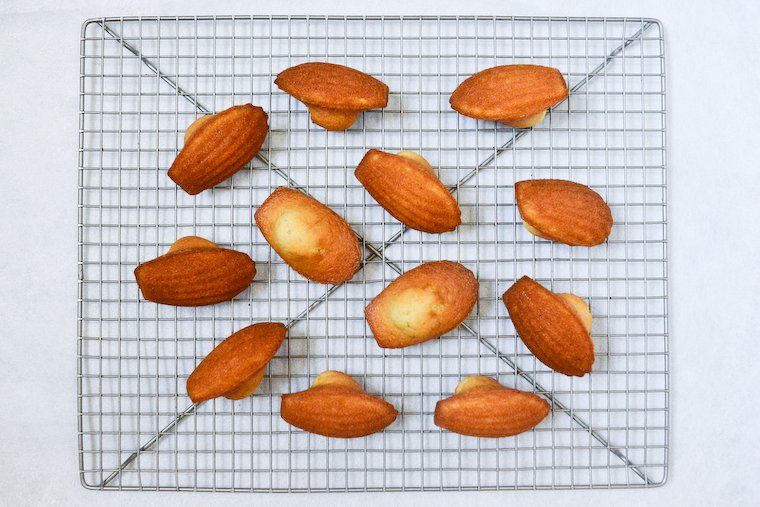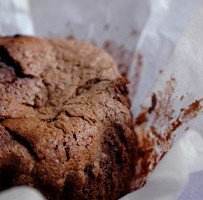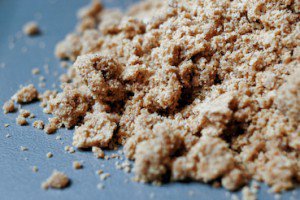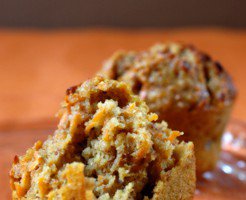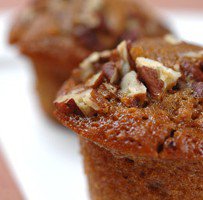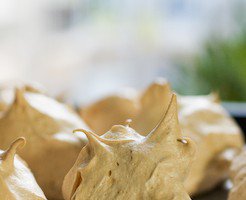Madeleines have long eluded me.
I have spent a good portion of my baking life collecting various recipes and giving the promising ones a try every now and then, but my efforts were only ever rewarded with ho-hum results, pale and dense little pucks that stuck to the mold like nobody’s business and flatly refused to form a bump.
Granted, if my temperament as a baker was to latch on to such challenges and tweak and tweak tirelessly until I unlocked the secrets of this or that pastry, I would probably have solved this one some time ago. But the way I deal with baking hurdles is more along the lines of “try, fail, forget about it and move on; try again, fail again, move on again, etc.”
As they baked and I stared in through the oven door, hardly believing my eyes that the centers slowly rose to form the oh-so-elusive bumps, I heard a deep voice echoing through the kitchen, saying, “Your Quest Stops Here.”
This time, the nudge to try again came from my two-year-old, who developed his own brand of madeleine obsession, one that is more centered on the eating of said madeleines. We were going through packs from the organic store at a rapid clip, and at 3.50€ ($4.80) for ten, I thought I might as well bake them myself.
I decided to put my fate in the hands of Fabrice Le Bourdat, owner and pastry chef of Paris pâtisserie Blé Sucré, using the recipe for his signature madeleines — plump, golden, fist-sized, and lemon-glazed — as shared on video for the Fooding website*.
It’s a beautifully straightforward recipe that is easily (and best) made by hand — I first made the mistake of using my stand mixer, and let’s just say pouring in hot melted butter while the motor is running is not pretty — and it yields absurdly perfect madeleines: buttercup yellow, softly sticky bumps, lightly crisp edges, and fluffy, moist hearts.
As they baked and I stared in through the oven door, hardly believing my eyes that the centers rose slowly to form the oh-so-elusive bumps, I heard a deep voice echoing through the kitchen, saying, “Your Quest Stops Here.”
Looking at the recipe, I think the key elements that make it so astonishingly successful are these:
- Refrigerating the batter overnight and preheating the oven to high is what creates the temperature shock that causes the bump to form.
- Using a piping bag to fill the madeleine molds may sound fussy, but it is in fact immeasurably easier than using a spoon — the batter is pretty sticky — and it ensures the madeleines are neatly formed and evenly sized, which in turn makes them bake evenly.
- Carefully buttering and refrigerating the madeleine tray, then assertively banging the tray sideways on the counter right out of the oven prevents the madeleines from sticking — they pop right out! — and the moisture from building up on the madeleines’s underbelly as they cool.
A few parting comments and words of advice:
- Overfilling the molds will get you duck-billed madeleines (see picture below) that your toddler may recognize as such and specifically request (“Madeleine canard !”) but may not meet your own standards of aesthetics.
- I altered Le Bourdat’s recipe slightly, reducing the amount of sugar (from 300 to 250 grams), adding salt, using a mix of baking soda and baking powder, and adding lemon zest as a classic flavoring. Feel free to omit it, or substitute the zest of another citrus, or vanilla, or orange flower water.
- You can certainly dream up all kinds of wilder flavorings, but I encourage you to try these simple flavorings first, to experience the beauty of the plain madeleine. You can always eat them with alternating bites of dark chocolate.
- The madeleines sold at Blé Sucré are topped with a lemon glaze, which is quite lovely, but messier for little hands to deal with. Up to you.
- Watch your madeleines closely as they bake — especially your first batch — to determine the exact baking time that works for your own oven’s idiosyncrasies. Since madeleines are small, it can be a minute between perfect and overbaked.
Join the conversation!
Have you had success baking madeleines in the past? Or is this the nudge you needed to give it a go? Are you an advocate of plain madeleines, or are you just dying to add in chocolate chips and blueberries and bacon bits?
* Here’s my own grainy video baking my chocolate and zucchini cake for that same website.
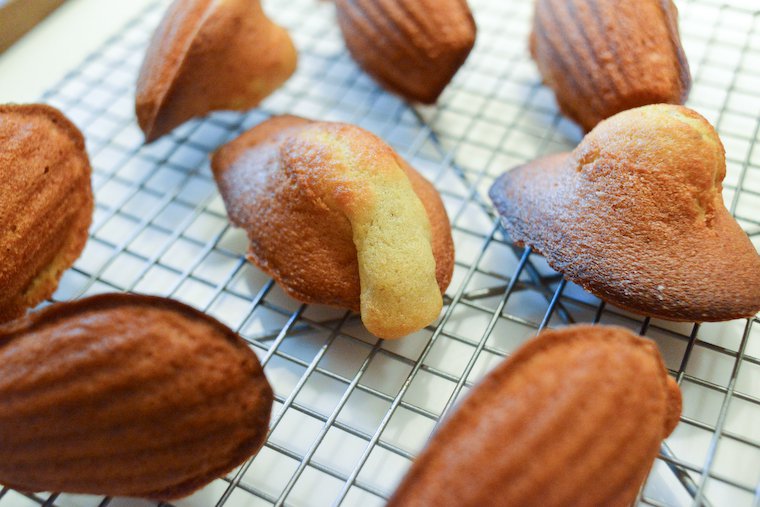
Duck-billed madeleine: this is what happens when you overfill the molds.

Have you tried this? Share your pics on Instagram!
Please tag your pictures with #cnzrecipes. I'll share my favorites!
Ingredients
- 6 large eggs
- 250 grams (1 1/4 cups) unrefined blond cane sugar
- Zest of one organic lemon, finely grated
- 120 ml (1/2 cup) milk
- 375 grams (13 1/4 ounces, about 2 3/4 cups) all-purpose flour, plus more for sprinkling
- 1 tablespoon baking powder
- 1 teaspoon baking soda
- 1/2 teaspoon fine sea salt
- 400 grams (1 3/4 cups) melted unsalted butter, hot, plus more for brushing
Instructions
- Prepare the batter the day before. In a large mixing bowl, whisk the eggs with the sugar and lemon zest, then whisk in the milk.
- In a medium mixing bowl, combine the flour, baking powder, baking soda, and salt, and stir with a clean whisk to remove any lump. Sprinkle the flour mixture into the wet ingredients, whisking all the while.
- Whisk in the melted butter, cover, and refrigerate until the next day. The batter will keep, tightly covered and refrigerated, for up to three days.
- Two hours before baking, brush a madeleine tray (preferably tin) with melted butter, making sure no excess butter pools in the ridges. Sprinkle the mold thoroughly with flour, then tap upside down over the sink to remove excess flour. (After my first batch, I forgot to flour the mold and merely buttered it, which turned out to be enough to prevent sticking.) Place the tray in the refrigerator for 2 hours.
- Preheat the oven to 230°C (450°F).
- Pour some of the batter into a piping bag fitted with a plain tip. (To make this step easier, you can place the piping bag in a tall measuring jug and fold the sides over and out to keep it open.)
- Pipe the batter into the prepared madeleine tray, filling each mold to three quarters. Bang the tray once on a cutting board (or your counter if it's sturdy) to remove any air bubble.
- Insert into the oven, lower the heat to 180°C (360°F), and bake for 12 minutes, until the sides of the madeleines are golden brown and the domes buttercup yellow.
- Remove from the oven and unmold immediately: holding the tray with both hands, tilt it forward so the madeleines face away from you, and bang the side of the tray on your cutting board or counter so the madeleines will pop out. Depending on how well-seasoned your tray is, it may take one to three bangs to pop them all out.
- Transfer to a rack to cool. The madeleines freeze well in an airtight container.

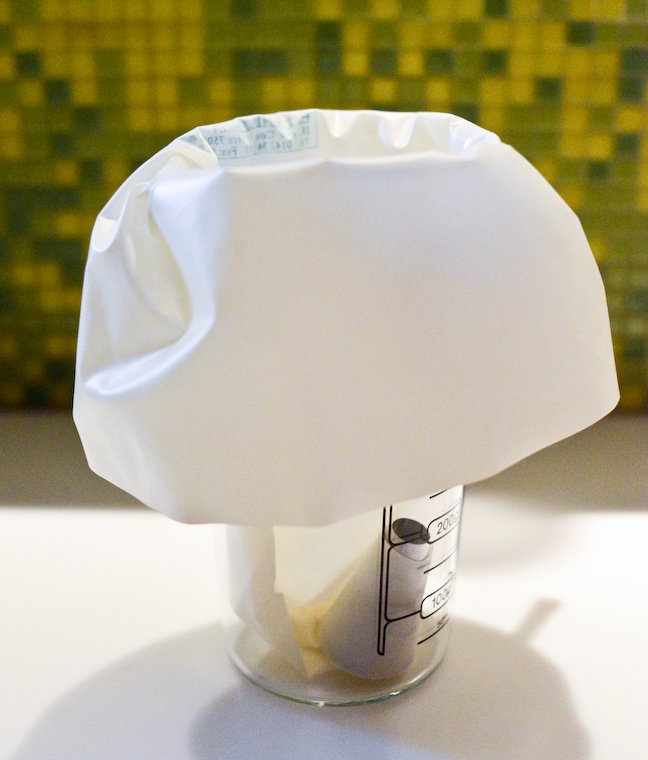
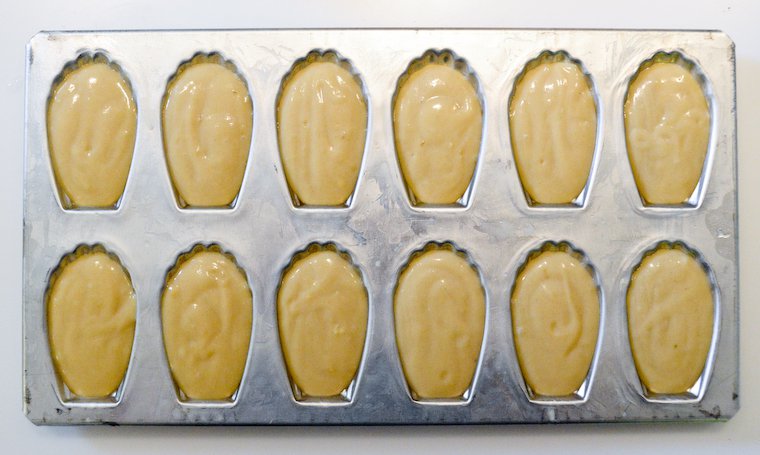
Notes
Adapted from a recipe by Fabrice Le Bourdat, pastry chef and owner of Blé Sucré, as seen on Le Fooding.


